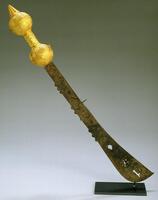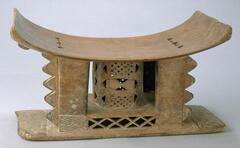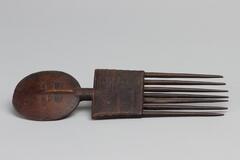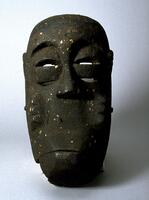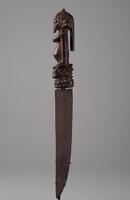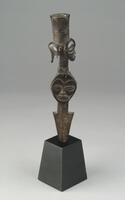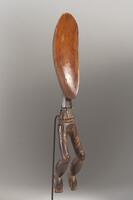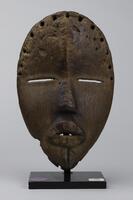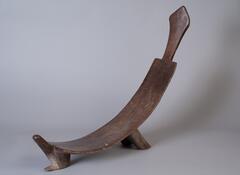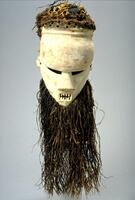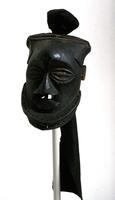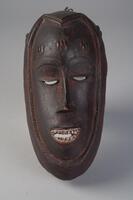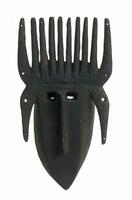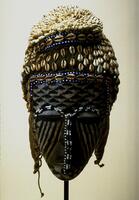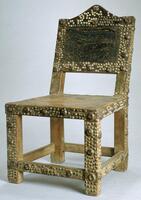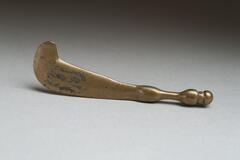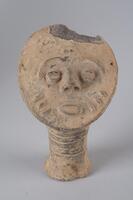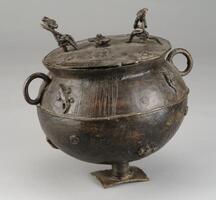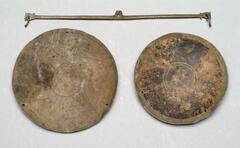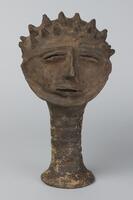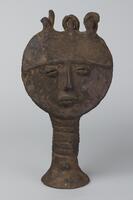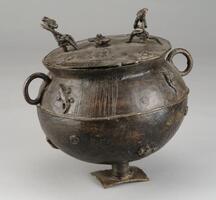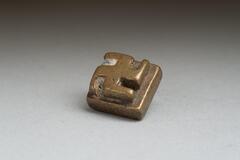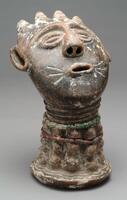35 Items in this Learning Collection
Collection Object
Collection Object
Collection Object
Collection Object
Collection Object
Collection Object
Collection Object
Collection Object
Collection Object
Collection Object
Collection Object
Copyright
All Rights Reserved
()
Mask (Kasangu)
Accession Number
1971/2.44
Title
Mask (Kasangu)
Artist(s)
Salampasu
Artist Nationality
Salampasu
Object Creation Date
1920-1960
Medium & Support
wood, raffia, kaolin and fiber
Dimensions
22 15/16 in x 9 7/16 in x 8 1/4 in (58.3 cm x 24 cm x 21 cm);22 15/16 in x 9 7/16 in x 9 13/16 in (58.3 cm x 24 cm x 25 cm)
Credit Line
Museum Purchase assisted by the Friends of the Museum of Art
Label copy
March 28, 2009
These formidable masks played a vital role in the Sala Mpasu’s warrior society, a powerful association through which men increased their authority by securing the right to wear particular masks. The most prestigious of these were the idangani masks, which represented a married couple and were constructed entirely from fiber. The female mask is identified by the small fiber knobs that recall a popular woman’s hairstyle. The kasangu mask was made of wood and represented a warrior. Its open, rectangular mouth exposes pointed teeth—a Sala Mpasu mark of beauty.
As new forms of authority and wealth were imposed by the Belgian colonial state, the Sala Mpasu disbanded their warrior society and destroyed many of the masks associated with it. However, the resilience of Sala Mpasu artists remains evident in the new forms of masks they continue to create for entertainment, boys’ initiation ceremonies, and the external art market.
Subject matter
In pre-colonial Sala Mpasu society authority was vested in members of the Matambu warriors’ society who could secure the rights to wear an array of important masks. The kasangu mask was made of wood and represented a warrior. Covered in kaolin, a fine white clay, it is distinguished by its open rectangular mouth and pointed teeth—a Sala Mpasu mark of beauty.
Physical Description
Face mask made of wood, covered in white kaolin; face has round, bulging forehead, deep set narrow eyes, small round ears, fiber beard, open rectangular mouth and pointed teeth; basketry weave that held mask on the dancer’s head is visible at back and sides; raffia attachment on top of head frayed and missing.
Primary Object Classification
Wood and Woodcarving
Primary Object Type
mask
Collection Area
African
Rights
If you are interested in using an image for a publication, please visit http://umma.umich.edu/request-image for more information and to fill out the online Image Rights and Reproductions Request Form.
Keywords
face masks
masquerades
prestige
wood (plant material)
1971/2.44
Title
Mask (Kasangu)
Artist(s)
Salampasu
Artist Nationality
Salampasu
Object Creation Date
1920-1960
Medium & Support
wood, raffia, kaolin and fiber
Dimensions
22 15/16 in x 9 7/16 in x 8 1/4 in (58.3 cm x 24 cm x 21 cm);22 15/16 in x 9 7/16 in x 9 13/16 in (58.3 cm x 24 cm x 25 cm)
Credit Line
Museum Purchase assisted by the Friends of the Museum of Art
Label copy
March 28, 2009
These formidable masks played a vital role in the Sala Mpasu’s warrior society, a powerful association through which men increased their authority by securing the right to wear particular masks. The most prestigious of these were the idangani masks, which represented a married couple and were constructed entirely from fiber. The female mask is identified by the small fiber knobs that recall a popular woman’s hairstyle. The kasangu mask was made of wood and represented a warrior. Its open, rectangular mouth exposes pointed teeth—a Sala Mpasu mark of beauty.
As new forms of authority and wealth were imposed by the Belgian colonial state, the Sala Mpasu disbanded their warrior society and destroyed many of the masks associated with it. However, the resilience of Sala Mpasu artists remains evident in the new forms of masks they continue to create for entertainment, boys’ initiation ceremonies, and the external art market.
Subject matter
In pre-colonial Sala Mpasu society authority was vested in members of the Matambu warriors’ society who could secure the rights to wear an array of important masks. The kasangu mask was made of wood and represented a warrior. Covered in kaolin, a fine white clay, it is distinguished by its open rectangular mouth and pointed teeth—a Sala Mpasu mark of beauty.
Physical Description
Face mask made of wood, covered in white kaolin; face has round, bulging forehead, deep set narrow eyes, small round ears, fiber beard, open rectangular mouth and pointed teeth; basketry weave that held mask on the dancer’s head is visible at back and sides; raffia attachment on top of head frayed and missing.
Primary Object Classification
Wood and Woodcarving
Primary Object Type
mask
Collection Area
African
Rights
If you are interested in using an image for a publication, please visit http://umma.umich.edu/request-image for more information and to fill out the online Image Rights and Reproductions Request Form.
Keywords
face masks
masquerades
prestige
wood (plant material)

